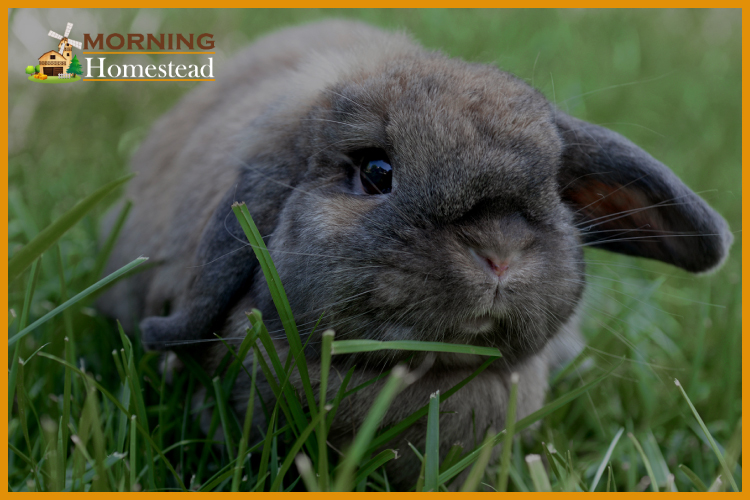Last Updated on March 8, 2024 by Georgie Smith
As homesteaders, the ultimate goal is to pursue a life of self-sufficiency. While many animals play a part in the homesteading lifestyle there is hardly one critter that fits homesteading goals better than rabbits.
Basic Comparison:
SSL
Storage
Domains
Sub-domains
Wheelbarrow
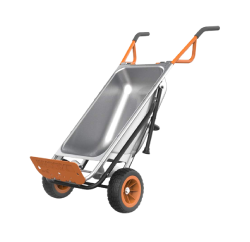
Brand - WORX
Material - Metal
Color - Orange
100 sub domains
Small Pet Select

Brand - Small Pet
Flavor - Timothy Hay
Range - Adult
Species - Guinea Pig
Wire Cutters

Brand - IGAN
Stainless Steel
Color - Red
Weight - 0.2 Pounds
This guide is a how-to plan to successfully include rabbits in your homestead. If you are new to rabbits or considering rabbits specifically as a pet versus for homestead production, we recommend you read our “Ultimate Beginners Guide to Basic Rabbit Care.”
The Ethics Behind Rabbit Raising
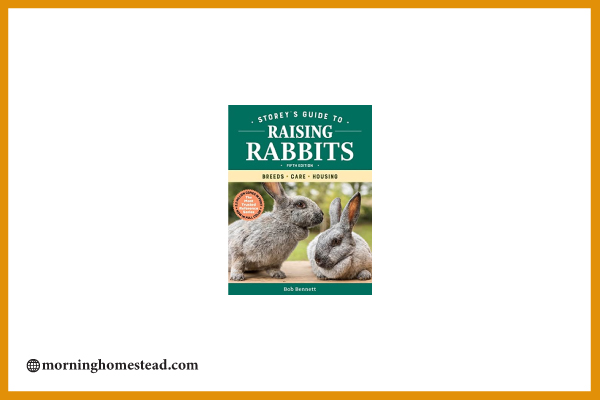
Rabbits can evoke strong emotions. Many people who consider rabbits only for pets may be upset to read some of the things discussed in this piece. Yet, for homesteaders needing a safe, clean and affordable source of protein, rabbits are one of the most obvious animals to raise.
Breeding rabbits and raising baby rabbits (kits) is a very ‘cute’ thing to do. Some people breed their rabbits because they simply want ‘adorable baby rabbits.’ Whether you believe rabbits should be pets only or are raising them for meat, a responsible rabbit raiser should NEVER purposefully breed rabbits if you can’t keep (or eat) all of them yourself. Good rabbit pet homes are very hard to find and there are already way too many irresponsible backyard breeders who breed indiscriminately and then, when they can’t find homes or afford them, dump them at over-extended rescues. Or worse still, let loose them loose in the wild.
Any person who purposefully breeds rabbits – even if you plan to keep all the babies yourself – still needs to learn how to humanely ‘cull’ (aka kill) an injured or suffering rabbit. Rabbits easily get injured or suffer from a disease. Breaking their back, for instance, is a tragedy many rabbit owners have experienced. These things typically seem to happen at a time when you can’t get them to a vet and there is no treatment option anyway.
It is not humane to allow animals to suffer needlessly and it is our responsibility as homesteaders and caretakers to be prepared to quickly, and painlessly, dispatch a suffering animal when needed. If you feel you cannot personally do this task, then make sure there is somebody in your family that can BEFORE you start the venture of raising rabbits.
It is ultimately your responsibility for the quality of life, and the humanity of the death, for any animal you raise on your homestead.
Why Raise Rabbits for Your Homestead?
Rabbits are any easy production animal to raise on a farm or homestead. They take up little space, are quiet and clean, don’t eat much and reproduce prolifically.
Rabbits are one of the most efficient livestock animals at converting feed to meat. Rabbits will produce six pounds of meat fed the same amount of food and water that a cow would produce just one pound off of.
Good meat rabbit breeds grow so fast they reach butcher weight within 10 weeks from birth. Two does and a buck can easily produce 300 pounds of meat in a single year, potentially even double that for high-producing does that routinely produce 12 plus kits a litter.
Rabbit meat is mild, lean and extremely healthy. It has about half the cholesterol of more typical meats such as chicken, turkey, beef, pork or lamb. It is also extremely versatile, can be ground for burgers or sausage, roasted, fried, and turned into jerky. There are 100s of recipes for rabbit meat.
Because you can so easily grow rabbits yourself, you can assure that your meat is grown without hormones, antibiotics, steroids and fed only healthy, naturally-grown and organic feeds.
Rabbit meat is also a popular ‘raw food’ for dogs on a raw food diet as well as being a common ingredient in commercial dog and cat food. Many homesteaders that have Livestock Guardian Dogs to guard their livestock raise rabbits to feed their dogs, as well as themselves.
Rabbits Produce More than Just Meat – Pelts, Wool and Poop!
Rabbits produce more than just meat. Rabbit pelts are easy and fun to tan and process. Pelts can be made into all sorts of attractive and useful items, including blankets, clothing, bags, hats, slippers and almost anything you can imagine. Click HERE for the basics of tanning rabbit pelts.
Wool rabbits – primarily the Angora breeds – produce wool that is harvested without harming the rabbit. That fiber than can then be spun into yarn or felted for family clothes or to be sold. Well-bred Angora rabbits can produce anywhere from four to 10 ounces of prime angora fiber two to even three times a year. Quality angora fiber commands a high price and is typically it is sold for $10 an ounce or more.
But there is one more product that rabbits produce – in abundance – that many new rabbit’s owners don’t consider until they are forced to deal with it —rabbit poop!
Rabbit manure is one of the best natural fertilizers around. It produces four times as many nutrients as cow or horse manure and twice as many as chickens. But it is not ‘hot’ like chicken manure. Which means you can spread rabbit manure directly onto a plant and not harm it.
(Note of caution – to prevent the spread of disease, NEVER spread fresh, un-composted manure of any kind in a planting bed or area where vegetables will be harvested within 120 days of the manure being spread!).
Rabbit poop also is not too smelly (compared to most other manure!) andis easy to manage and move around. Just try cleaning up a few cow stalls versus your rabbit hutches and you’ll soon agree. And a final vote for rabbit poop, worms LOVE rabbit manure. Some rabbit owners even create worm bins directly beneath their rabbit hutches and then harvest the rich worm casings for the ultimate in garden compost.
Read more about using rabbit manure HERE.
Recommended Tools for Managing Your Rabbit Manure!
Gorilla Cart Wheelbarrow

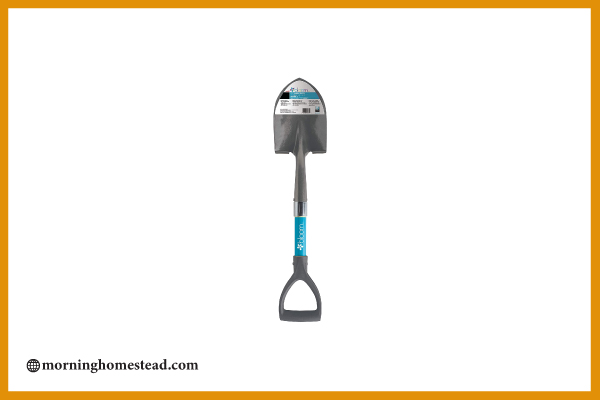
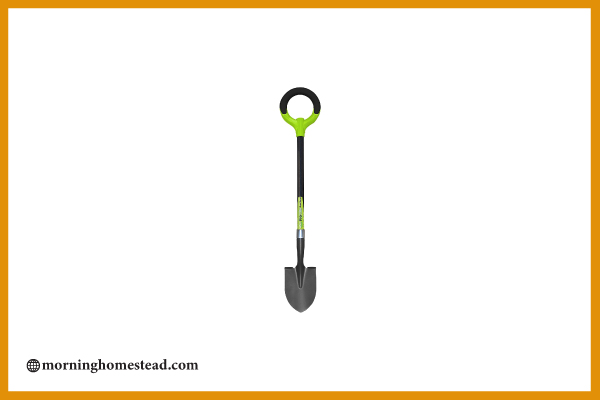
Setting Up Your Rabbitry – Cages versus Colony versus Tractors
The first thing to think about when setting up your rabbitry is to what your set-up will be. There are three basic philosophies of raising rabbits in a homestead situation. Each set-up has advantages and disadvantages and it will depend on what is most important and works best for you. You might end up combining several methods.
Raising Rabbits in Cages
Rabbits raised in cages are housed individually in wire bottoms cages that allow the manure to fall through either to a catch tray, or directly to the ground. Wire bottoms should always be at least 14-gauge wire, with ½” by 1” holes or it will not be strong enough to support the weight of the rabbit. The sides are a bit more flexible, but for best predator prevention we still recommend a strong 14 to 16-gauge wire, 1”x2” holes.
The cage itself might be framed out in wood, or an all-wire cage, or a wire cage that rests inside of a wood hutch frame. Keep in mind, rabbits love to chew so any wooden sided cage the rabbits can get their teeth on will take a lot of wear and tear from the rabbits themselves.
Rabbits raised in cages are typically housed individually unless it is a doe with a litter or it is a ‘grow-out’ pen consisting of a litter that has recently been weaned. You need to make sure to provide enough cage space for your rabbits depending on their size.
The recommended cage space minimums for rabbits, according to the American Rabbit Breeders Association guide standards:
- Small Rabbits (4.4 lbs and less) at least 1.5 square feet with at least 14 inches height.
- Medium Rabbits (4.5 lbs to 8.8 lbs) at least 3 sq. ft with at least 14 inches height.
- Large Rabbits (8.8 lbs to 11.9 lbs) at least 4 sq. ft with at least 14 inches height
- Giant Rabbits (11.9 lbs plus) at least 5 sq. ft with at least 14 inches height
For a large rabbit then, this might be a 2’x2’ cage that is at least 14 inches height. More is always better, but keep in mind if you make your cages too deep, it will be hard to reach in and clean well (it is not recommended to go deeper than 3’ for that reason!).
Does with a litter should have at least the following minimum cage space:
- Small Doe with Litter – 4 sq. ft with at least 14 inches height
- Med Doe with Litter – 5 sq. ft with at least 14 inches height
- Large Doe with litter – 6 sq. ft with at least 14 inches height
- Giant Doe with litter – 7.5 sq. feet with at least 14 inches height
While 14 inches height is the recommended minimum, many rabbit owners prefer increasing to 18 inches or even 24 inches in height to allow them to put in shelves for rabbits to jump onto. This is also nice for does and litters because it allows the doe to ‘escape’ her kits when they are being pesky!
What kind of cage you create can vary widely. Some rabbit owners buy stacking cages with drop pans (or install a manure management flushing system if they get high tech!). This allows many cages in a relatively small space, typically installed in a barn or shed. Other rabbit owners build single-layer, individual hutches outside. Often made from whatever materials they have available to build them with as cheaply as possible. There are 100s of ideas for different DIY rabbit hutch designs for those with a little ingenuity and construction skills.
Link to easy DIY rabbit hutch.
Good Stuff and Bad Stuff of Raising Rabbits in Cages:
Good Stuff
Bad Stuff
Supplies For DIY Wire Rabbit Cages
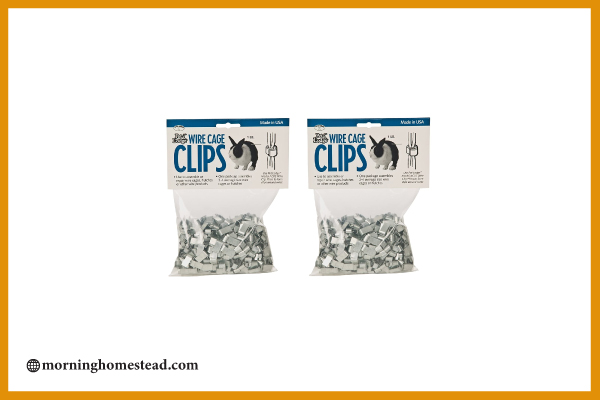

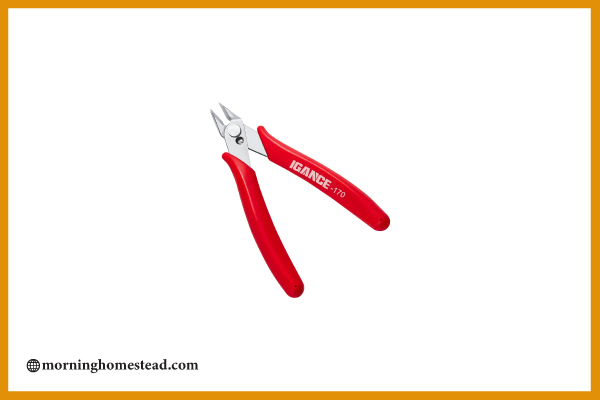
Make sure to get 14 Gauge Wire 1/2” x 1”
for floors! It can be hard to find. Try this link.
Pre-Cut Wire Rabbit Kits – We Suggest You Still Get Wire Clip Pliers and Wire Cutters
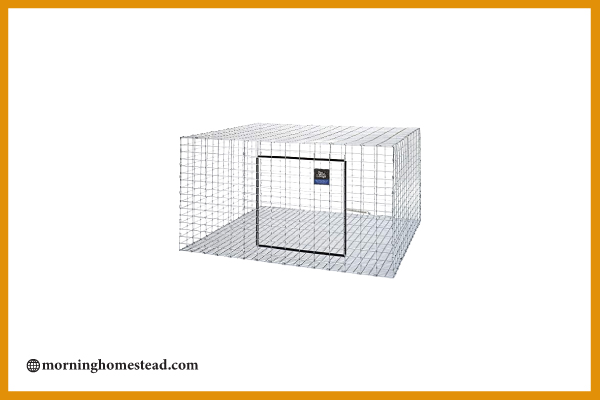
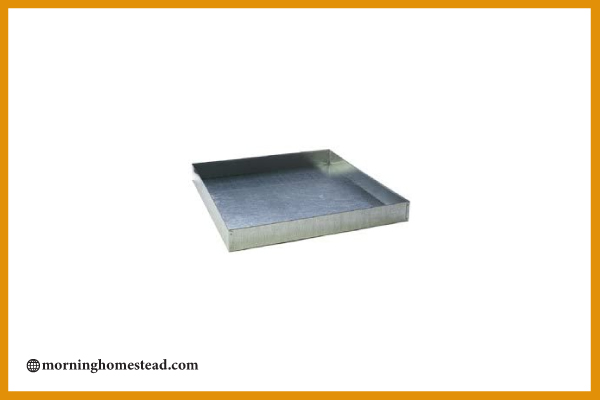

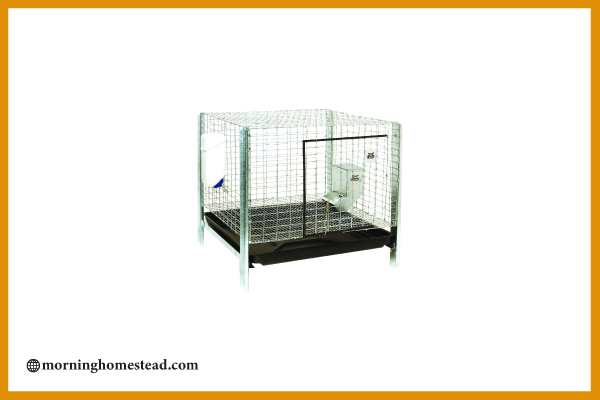
Raising Rabbits in a Colony
Colony rabbit raising requires a large area, either outside or in a barn or shed, where rabbits are allowed to roam and live with each other.
You need more space per rabbit in a colony. This is because rabbits are territorial, so if you put them all together, they need plenty of space or they will fight – even to death. It is typically recommended that you have 10 sq. feet per rabbit in a colony-style system.
You will also need places for the rabbits to escape or hide from each other. Either utilize open hutches they can access within the colony or other things they can turn into a burrow.
If you decide to set up a colony outside, one of the biggest issues is that rabbits can (and will!) burrow extensively into the ground, including ‘out’ of your space. Rabbits in the wild have been known to dig burrows up to 10 feet deep and spanning almost 150 feet! You will need to dig a wire boundary around the perimeter, recommended you sink the wire at least 6 inches down, preferably up 10 inches. In colonies set up in a barn or shed with a concrete floor, this problem can be avoided, though rabbits will still happily chew through wood walls so be prepared for that.
Also, if the colony is outside it will need to offer areas that protect the rabbits from the elements as well as predators. Overhead predators (like eagles and owls) can be a serious problem to outdoor colonies so plan to add wire on top of your colony area if it is located outside.
You will need several feeding and watering areas to ensure all the rabbits can access food and not let a few of the big “piggy’ rabbits take up all the good stuff and crowd out the skinny or young ones.
A key factor will be deciding if you let bucks run loose in a colony and then have does bred often and at uncontrolled times. If you do that, be prepared to deal with lots of young rabbits at all different times! Some rabbit raisers create colonies, but separate does and bucks and only put bucks in with does when they want to breed. Every rabbit owner works out the best system for them, but it is our recommendation that if you do implement a colony system, create separate buck and doe areas so you can control and monitor the breeding frequency and litter health.
Good Stuff and Bad Stuff of Raising Rabbits in Colony Style:
Good Stuff
Bad Stuff
Colony Fencing Supplies
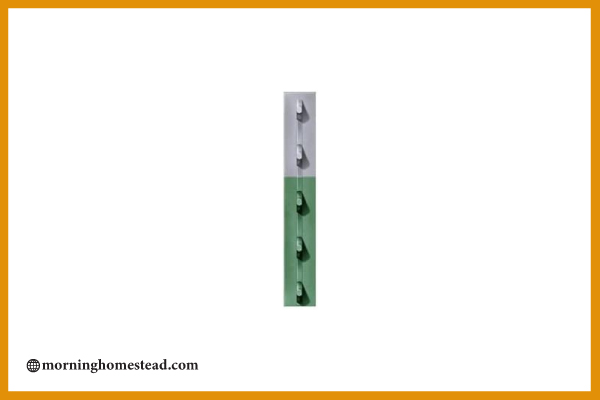
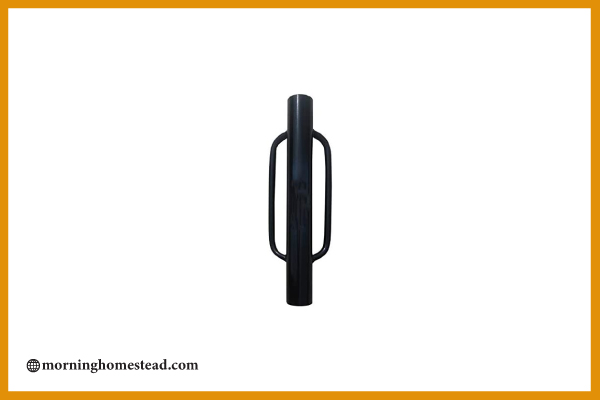
Rotational Pasture-Raising Rabbits or “Rabbit Tractors”
Rotational pasture-raising rabbits or ‘rabbit tractors’ is similar in many ways to colony-style raising, only the area is ‘rotated.’ Some meat rabbit raisers prefer this method to give their rabbits frequent access to fresh grass. Or, they might create a ‘grow-out’ tractor for young rabbits being raised for later processing. It requires special, ‘moveable’ cages to be built to house the rabbits.
Pros and Cons of Raising Rabbits on Rotational Pasture
Good Stuff
Bad Stuff
Plans for a DIY rabbit tractor HERE.
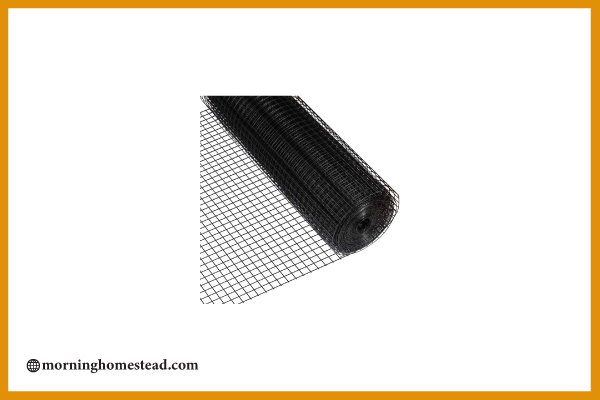

Most of the Rabbit Tractor Supplies are Easily Sourced at Hardware or Lumber Stores.
Selecting Your Breeding Stock for Rabbit Farming
For healthy rabbits producing large litters and the products you want (meat, pelts or wool) you need to start with rabbits that come from excellent stock. While you don’t have to purchase ‘purebred’ (aka pedigreed) rabbits to start your rabbitry, especially in a homestead situation, it is still advisable to think about what breeds you want first. Then find rabbit breeders with a reputation for offering high-quality stock in those breeds.
What breeds you choose will depend on your priorities. There are a LOT of rabbit breeds that are potentially useful in a homestead situation.
For tips on finding sources for your rabbit stock, how to conduct a basic health check and how to tell if the person you are getting rabbits from is reputable, please refer to our “The Ultimate Beginners Guide to Basic Rabbit Care.”
Feeding Strategies for Successful Rabbit Farming
There are many feeding strategies for raising rabbits, but it will come down to the style of rabbitry you set up (cage versus colony versus tractor), the breeds you select plus your access to different feeds. If you are new to rabbits, please do refer to our “Ultimate Beginners Guide to Basic Rabbit Care” which covers the basic feeding principles for rabbits.
Ultimately it comes down to finding a system that most efficiently raises healthy rabbits with the least amount of cost.
To produce high-quality meat, pelts and wool you’ll want to feed at least 16 percent protein and as much fiber as possible – at least 14 percent but higher is better. Rabbits don’t need a lot of fat, around three percent is typically recommended although lactating does do require more.
The most measurable way to do that is with pellets showing the percentage of protein and fibers available on each label. However, some rabbit farmers, especially homesteaders, prefer to stay away from pellets and instead might choose to feed a mix of greens, hay, and other supplements.
Many rabbit owners experiment with some, or all, of the following feeding systems and ideas and eventually work out a routine that fits their lifestyle (and rabbits) best.
PELLETS – An ‘all-inclusive’ feed that has all the things needed. Many rabbit owners argue rabbits ‘only’ need good-quality pellets.
Good Stuff
Bad Stuff
Tips for sourcing pellets:
- Most feed stores don’t stock the ‘big bags’ of commercial rabbit pellets upfront. Ask what rabbit feeds they stock in the big bags for a much better price and selection.
- Many regions have local ‘feed mills’ that custom mill feeds and sell direct. Ask around if there if a local mill in your area. You can typically get very good quality, fresh feed for an excellent price.
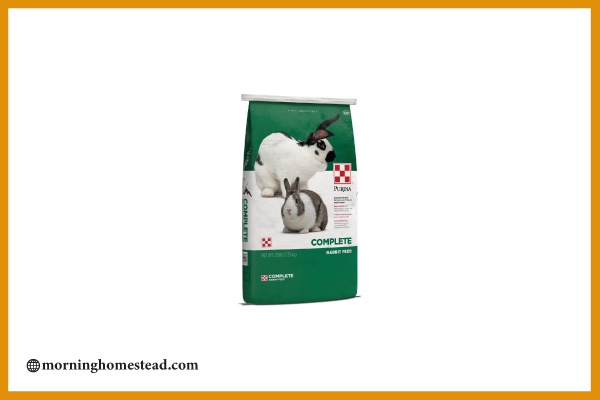
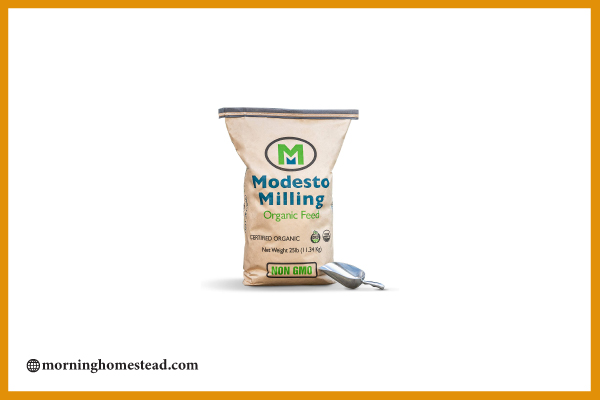
- FORAGE FEEDING – A system of foraging greens and vegetables either you raise yourself or source. Foraged plants and vegetables that can be used in a forage feeding system might include just simple grasses from your yard and common weeds like dandelions, chickweeds, plantain, and blackberry leaves.
Good Stuff
Bad Stuff
For more information on forage, and feeding strategies read THIS blog post.
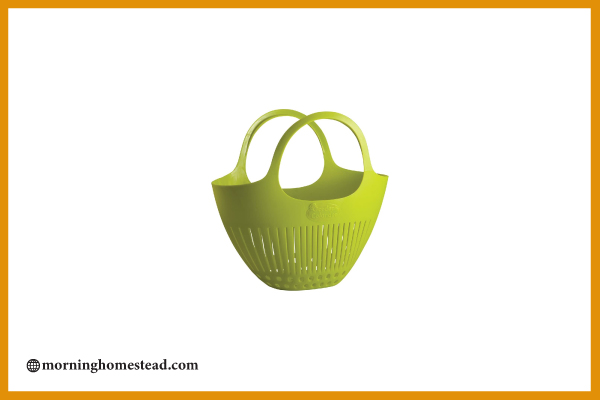
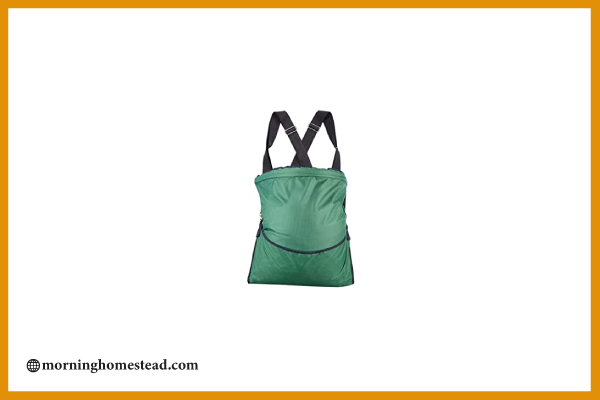
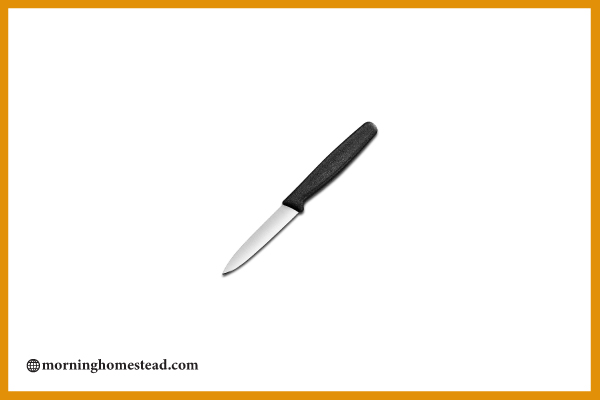
- FODDER FEEDING – A system of sprouting grains, typically barley or wheat, in controlled environments to quickly produce a highly nutritious, easily digestible food source.
Good Stuff
Bad Stuff
For more information about fodder-feeding rabbits click HERE and for concerns about fodder-feeding click here.
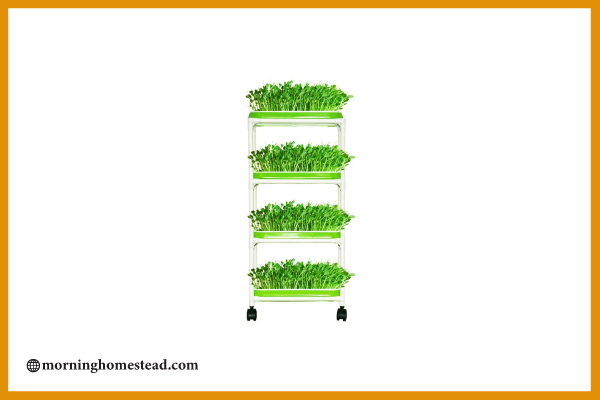
Supplemental Feeds – There are many other products that can be fed to rabbits.
Many rabbit owners experiment with some, or all, of the following feeding systems and ideas and eventually work out a routine that fits their lifestyle (and rabbits) best.
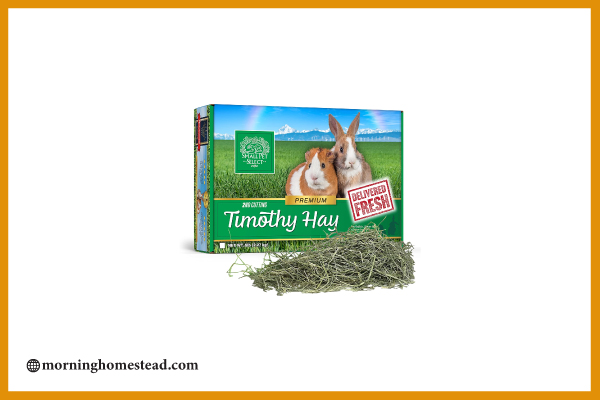
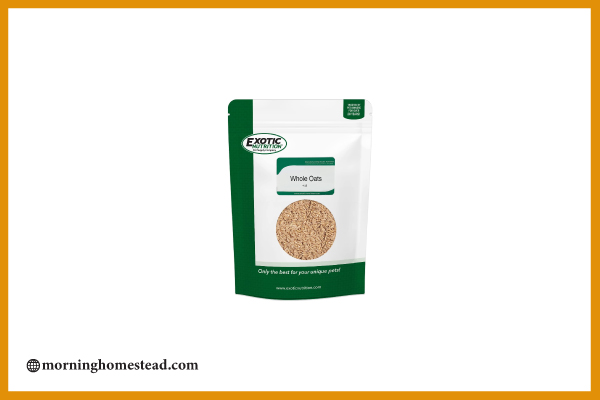
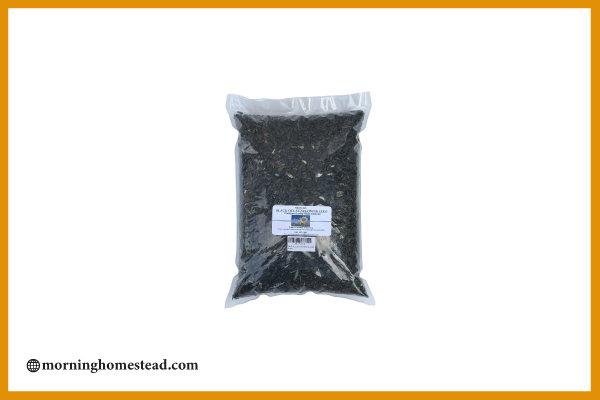
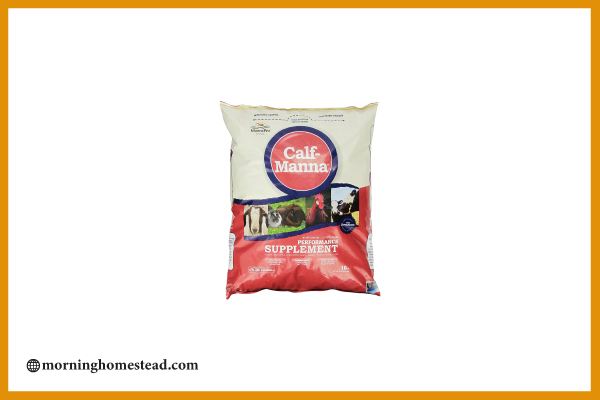
How Much to Feed Your Rabbits
Lactating does with litters and ‘grow-out’ pens of young rabbits being raised to butcher weight are typically free-fed as much as they will eat. Young rabbits are growing rapidly and need a constant availability of feed to pack on their protein. Always have constant access to fresh, clean water.
For adult rabbits – does and bucks – kept for breeding pairs it is important to not overfeed. One of the most common reasons for pregnancy failure is being overweight. For similar reasons, pregnant does don’t need additional feed while pregnant or risk putting on too much weight causing problems with the birth. Actual feed amounts per rabbit can vary widely depending on what feeding system you use and if you supplement with different sources. The typical rule of thumb is one ounce of pellets per one pound of rabbit.
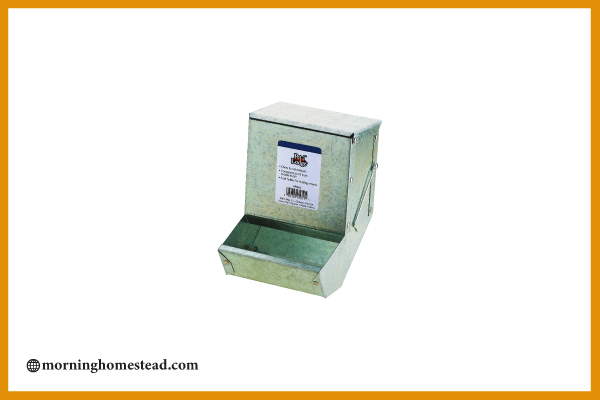
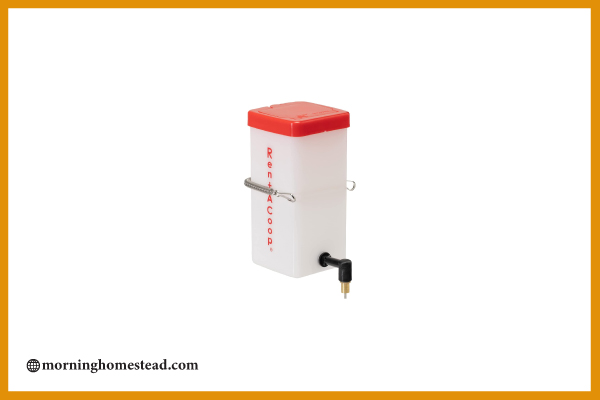
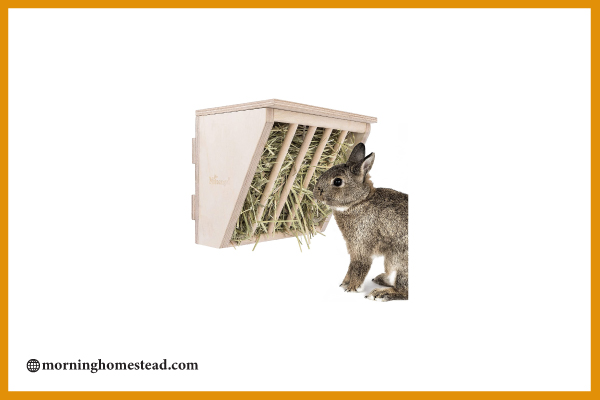
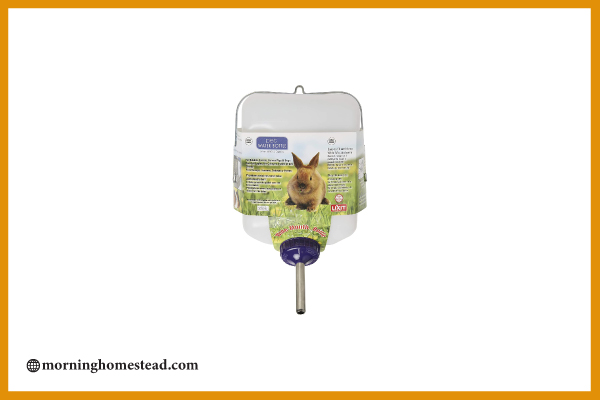
Breeding Basics for Raising Rabbits
Even though the term ‘breed like rabbits’ applies, purposefully breeding rabbits can present more challenges than many new rabbit raisers realize! Sticking to the fundamentals, having healthy rabbits and following a few tried and true ‘tips’ is the ticket to rabbit-breeding success.
How to Breed Your Rabbits
Rabbits are ‘induced ovulators’ which means they do not need to go into ‘heat’ to be bred. The acting of mating itself stimulates the doe to ovulate. That said, does typically tend to be more ‘receptive’ to bucks at certain times of the year. While rabbits can be bred in fall and winter, spring and summer matings are usually more reliably successful. Also, in very hot summer areas many bucks will get lazy and ‘refuse’ to breed!
A receptive ‘doe’ will typically stretch out and ‘lift’ her tail out of the way and vulva up for the buck (or even for your hand if you pet her along her back!). An unreceptive doe will frantically run away from the buck and may even fight the buck. Always observe. Pissed-off, unreceptive does are known to fight back viciously, even ‘neutering’ bucks by biting off their testicles!
Tips for Successful Rabbit Matings
- Always bring the doe to the buck.
- Rabbits are territorial, and if you bring the buck to the doe, the doe is more likely to fight and the buck is often more interested in marking the ‘new area’ than he is in mating the doe. In colony-type situations where bucks and does roam together, mating will take care of itself.
- Watch for a ‘Fall Off’
The act of mating in rabbits is very quick, usually just seconds. A successful ‘mating’ is typically counted if the buck ‘falls off’ the doe. As in, he literally falls off backward or to the side. If a pair is watched closely and a ‘fall off’ is not observed, it is often (though not always) an indication of a failed mating.
- Mate Twice
- Many breeders, after observing a successful fall-off, will separate the buck and doe and then return the buck after a few hours for a second mating.Rabbits have two horns in their uterus and a second breeding ensures multiple kits in each horn. Small, or single kit litters, are dangerous for both the doe and the kits. Single kits tend to get large and go past term causing birthing difficulties plus they don’t survive well without litter mates for warmth.
- Mark Your Calendar.
- Once a successful mating is observed (unless in a colony situation when you don’t know!), mark your calendar for birthing at 30 days out. While rabbits can go longer, even as long as 40 days gestation, most litters are born at the 30 to the 34-day mark.
Preparing for the New Litter
You must provide a good ‘nesting box’ and adequate nesting materials for a successful delivery. Nesting boxes can be made from many different things or purchased. You want the box to be about one and a half or two times the size of the doe, but not any bigger or the kits will have too much space to move around.
The nesting box should also have high enough sides, ideally a partial top to keep warmth in and a ‘lip’ around the lowest entry edge to prevent kits from wiggling out. Young kits are much more active (a common name for newborn kits is ‘popcorn’ because of the way the ‘jump’ around) than many rabbit owners realize and can easily wiggle out and find themselves out in the cold where they quickly perish. Does do not ‘put back’ a kit that leaves the nest (like a cat) so it is important to provide a nest box they cannot easily escape until they are big enough to survive.
If you are raising rabbits in a more colony-style situation, you will want to provide several ‘nest box’ type areas for does to use as needed since you will not be able to monitor when kits might arrive.
Getting the Nest Box Ready
- The nest box should be sanitized well and dried.
- Fill it with a few layers of pine shavings and then pack with straw and hay
- Place into the does cages at 28 days into gestation.
- Provide extra straw or hay in the does cage for the doe to start ‘nesting.’ She will also pull fur from her chest and stomach.
Some does will create elaborate nests days before kindling while some start it only minutes before going into labor. Others don’t build a nest at all. Just watch carefully as kindle date draws near and be prepared to help if needed. More about that coming next!
Typical Problems with Kindling
It is not uncommon for does, especially first-time mothers, to make one of several mistakes that end up with a dead litter. In rabbit breeding, you typically give a doe at least two to three chances to ‘figure out’ how to successfully kindle a new litter. If she has still had ‘no luck’ by the third time, that is a doe that should be removed from your breeding program.
Eating and Over-Cleaning Kits
Yes, you read that right, female rabbits do occasionally eat their kits. Even sometimes their entire litter! There are lots of theories about why this happens. The predominant one is that the doe has been scared by a predator and is concerned that the smell of the babies will attract one. So, they eat them. Some does, however, do it despite perfect conditions. The ‘three strikes you’re out’ rule applies here. This is not a good breeding doe for your homestead.
Many first-time mothers will get ‘over-zealous’ in cleaning newborn kits and accidentally bite off an ear, a limb or worse. Depending on the extent of the injury, newborn kits can be surprisingly resilient. They typically survive just find missing an ear (or even two!) and even three-legged kits are known to grow up just fine. It is up to the rabbit owner to check the extent of these types of injuries, treat as needed, and determine if humane cull is the best option.
After kindling, you should immediately check the kits looking for any injured or deceased ones. Dead kits in the nest will chill the other kits and cause sanitary problems in the box. Checking the kits quickly and daily, is a good way to head off any problems. However, don’t keep them out of the nest long as they easily can get cold.
Watch for Nestbox Eye
Nestbox eye is a typical problem in litters, especially if the nest box was not properly cleaned and sanitized. A kits eye will appear ‘stuck’ and crusted over and will not open at the usual time(typically at 10 to 14 days). If caught early, this can easily be fixed by a single soak with an animal-grade eye care rinse and a cotton ball and then treating with terramycin ointment. If left too long, the kit might need multiple daily treatments to clear the problem and may lose sight in their eye.
Growing Up and Out of the NestBox
Kits grow amazingly fast, and typically by two to three weeks they will be finding their way out of the nest box. This is a good time to turn the box on its side so any ‘early explorers’ can also find their way box into their cozy home. Once all the kits are moving around frequently, typically by three to four weeks, remove the nest box altogether.
Kits will start nibbling on their mother’s food as early as three weeks old. This is a good way to introduce them to food and the weaning process. It is very important to have the mother on a routine, steady diet at this point so when you do wean the kits, they can remain eating the same food.
Weaning Enteritis
Weaning enteritis, or inflammation of the digestive tract, is watery diarrhea that can come on suddenly and quickly kill your kits, sometimes in a matter of hours. There are many potential underlying causes for weaning enteritis, but typically the best way to prevent it is to avoid undue stress to the kits at weaning time.
Tips for Preventing Enteritis
- Remove the doe from the cage, rather than the kits. Moving to a new cage can be stressful for the kits especially without their mother. If you remove the doe for the first week and then move adapted kits over to a larger cage this helps prevent undue stress.
- No sudden feed changes! This is something that is stressed constantly with rabbits but it especially true for young kits.
- Offer grass or timothy hay. This keeps their digestive system working properly.
- Add probiotics to their water. Many rabbit owners swear by adding rabbit-recommended probiotics into their water for any stressed rabbits. This helps keep their gut flora and fauna healthy and working properly.
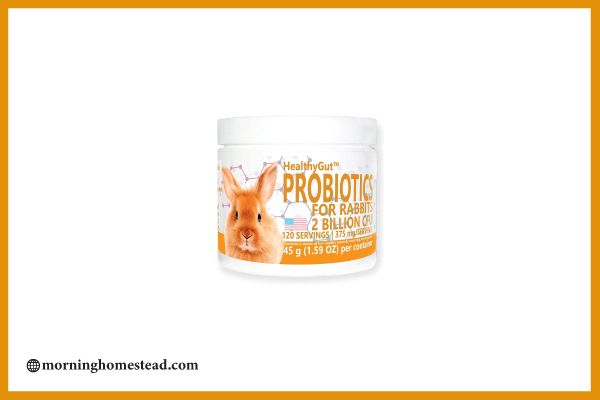
If you follow all the right protocols and continually have problems with weaning enteritis, it is probably indicative of some other issue within your rabbitry that your adult rabbits aren’t showing but the kits do because of their more fragile system. It might be coccidiosis, a worm issue or it could be problems with your feeding regime. But continual occurrence means you need to restock and rethink the overall health of your entire herd.
We hope you have enjoyed this guide to raising and breeding rabbits for a homesteader. Rabbits are easily one of the most fun, rewarding, and ‘common sense’ animals to raise on your homestead. The final step for a homesteader is learning how to humanely, safely, and efficiently process your rabbits for the freezer. That comes up next in our “Guide to Humanely Butchering Rabbits for Rabbit Meat”.

